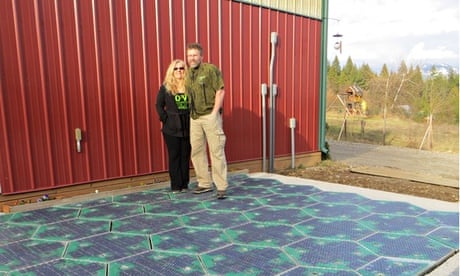Imagine driving your car out of the garage and what you see is not the usual dark grey asphalt but a street of blue-green hexagonal tiles, with lane markings and traffic signs lit up by embedded LED bulbs.
The image might seem surreal, but a couple in Idaho is working on making it a reality. Meet Julie and Scott Brusaw, who eight years ago started a project to build a roadway embedded with solar cells. Several private and public grants later, the Brusaws are now in the middle of a fundraising campaign via Indiegogo to raise money to hire engineers, improve the design and bring Solar Roadways to the marketplace.
The campaign has fascinated the public and is closing in on $2m, after surpassing the initial goal of $1m. "We need to tweak the design and look for a better way to manufacture them," said Scott Brusaw. "We've made the panels by hand."
Solar Roadways, the Brusaws' project, is certainly bold. They are not just proposing to build glass-topped solar panels that are rugged enough to withstand big trucks and heavy traffic and generate electricity for sale; they also envisage charging electric cars, perhaps wirelessly while the cars zoom down the highway. They are putting LED in the panels not only for marking roads but also for displaying advertising, at least for parking lot projects for businesses.
They're even looking at funnelling melted snow from the solar panels into an underground storage tank before sending it to a water treatment centre. Snow removal is critical to ensure the solar panels get sun, so the solar panels will be heated to melt the snow. But the melted water could refreeze and push up the panels if it's allowed to pool off the edge of the solar road, so funnelling is an option.
Note that all these proposed uses of a solar roadway are also ways for such a project to generate revenues. Figuring out ways to make a solar roadway project economically feasible will be a huge challenge, says Gregory Wilson, director of the National Center for Photovoltaics at the National Renewable Energy Laboratory, which is part of the US Department of Energy.
While the Brusaws are using some proven technologies, such as silicon solar cells and LED lighting, they need to design them to work well together and under weather and road conditions that pose different challenges to conventional solar panel installation (on a rooftop or in the field) or LED traffic signals and street lighting.
A novel technology often costs more, at least initially, until it's made in enough volume to reduce manufacturing expenses. Its price should also come down when there is enough demand to help recoup the initial research and development cost.
Then there is the expense of maintaining a solar roadway. It will require monitoring to make sure each panel is producing the expected amount of solar electricity. Repairing or replacing the components, if not each panel, will have to be easy to minimise the extent of roadway closures.
Keeping a solar roadway clear of dirt and debris and out of shade, all of which lower electricity generation, will also be crucial in making the project financially attractive, Wilson said. The Solar Roadway project is attempting to address many of these operational and maintenance issues.
While a solar roadway doesn't have to cost the same as concrete or asphalt, it has to generate enough revenue or other benefits to justify its cost. "I would love to see this project being economically viable," said Wilson. "It'll likely to be too expensive to be deployed everywhere. But it will have niche applications."
Just how expensive paving a mile with Brusaws' solar panels will cost is a big unknown. The company has yet to finalise its design, which will dictate the types of materials used and the cost of buying and assembling them into panels.
Scott Brusaw declined to discuss potential costs and said he will have a better idea about the manufacturing cost after he wraps up the prototype design, funded by the US Highway Administration, next month. The federal agency has given two grants, totalling $850,000, to the project.
The federal grants have made it possible for the Brusaws to show what they have come up with so far by paving a 12ft by 36ft space on their property with LED-embedded solar panels. The couple changed the shape of the panel from 12ft by 12ft square during the initial design to a hexagon. An assembly of hexagons, which collectively resemble the shape of a honeycomb, adds strength to the overall structure and also makes it easier for building curved roadways, Scott said.
Brusaw, who is an electrical engineer, wants to hire civil and structural engineers to help him to finalise the solar panel design. The current design uses two pieces of half-inch thick tempered glass to sandwich the solar cells, LED and other electronic components. Lab analyses show that a roadway using the current prototype can already handle 250,000lb, Brusaw said. The glass is textured to help reduce the extent of skidding when its raining.
The Brusaws wants to start making and selling their rugged solar panels before the end of the year. The city of Sandpoint, where the couple live, is set to become the first customer by installing the solar panels at a visitor centre parking lot.
The technology and innovation hub is funded by BT. All content is editorially independent except for pieces labelled advertisement feature. Find out more here.
Join the community of sustainability professionals and experts. Become a GSB member to get more stories like this direct to your inbox

Comments (…)
Sign in or create your Guardian account to join the discussion